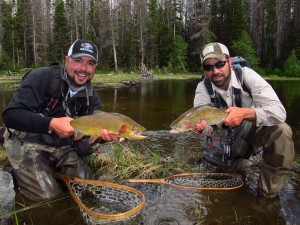Blue Wing Olive’s
It’s a pretty good sign that spring’s here when we start thinking about Blue Winged Olives. The BWO (Blue Winged Olive) is one of our favorite bugs. BWO’s are many species that are squeezed into three mayfly genera, Baetis, Pseudocloeon, and Diphetor. Snooty fly fishermen and wise entomologist are very particular about this but for the simple reason that tactics and appearance for the different species are nearly the same, we’ll lump them all into one group and call it BWO.
The BWO’s are tiny mayflies that are rarely absent from the stream and can’t be found in lakes. Hatches in North Park along the North Platte River and some of its tributaries can begin as early as March and continue through May, then start up again in September and last until the end of October or early November.
Nymphs live in all sections of the stream and seem to hatch in riffles and runs but the slower moving water holds the largest populations of nymphs. Because these nymphs like to eat “all day, every day” they often drift short distances in the current trying to find a new homes making subsurface fishing a very effective tactic even while the hatch is not happening. Most nymphs will do this early and late in the day or anytime there in cloud cover and tough weather.
Hatches generally start early in the afternoon around 1-2pm and are best on cloudy/ rainy days. If conditions are right hatches can last for 3-4 hours. Wind can be tough on the bugs making it hard for them to get back to the water to lay eggs thus hard for fish to eat them. A cool cloudy/rainy day with light winds is the recipe for an epic BWO hatch.
After mating the female spinners will return to the water to lay eggs. The different species have different methods of laying eggs making a plethora of fishing tactics work. The most common forms of BWO’s laying eggs can be described in two simple ways. The first form of BWO will dive into the water like a Caddis swimming to the bottom of the stream to clinch onto rocks and deposit eggs. Before entering the water they will fill their wings with gasses that will propel them back to the surface after they lay eggs. The second form of BWO crawls just below the surface and deposit their eggs on the downstream side of rocks, sticks, or logs. Both forms stimulate great subsurface fishing that can best be imitated by swinging a wet fly either just under the surface or weighted a few feet below.
During a BWO hatch it’s definitely most fun to fish a Dun or cripple high on the water giving the angler a super cool visual when the fish takes. However, as the hatch gets into full swing a wet fly imitation will probably always put more fish in the net.
A few Patterns we like:
Duns: BWO Ext Body#16-20, Para BWO #16-20
Cripple: Last Chance BWO #16-20, BWO Cripple #16-20
Soft Hackles: Hare’s Ear #16-20, Ph Tail #16-20




